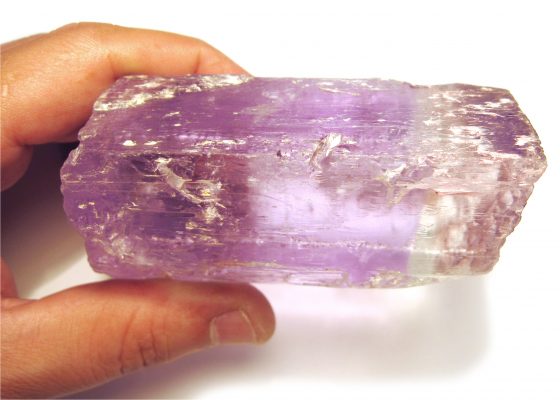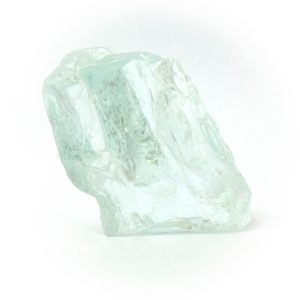Since I began to explore the world of precious stones for you, I have decided to learn the meaning of technical terms, difficult names, and a variety of different gemstone families. I shared my knowledge about gemstone colours, told of famous diamonds and every day I discover new, unknown stones. I have been taught what the cleavage of gemstones is, and the construction of their crystal structure. Likewise, I now know what is hidden behind the famous Spodumene and Pleochroism. But it seems to me, I’ve forgotten something essential: the beginning, or quite simply, how it all began…
Even though the area of mineralogy is still not 100% known to us, i will not begin this story with “once upon a time…” But let’s go back to the start.

Kunzite Rough Crystal
The First Aeon: Hadaikum
The term “Hadaikum” triggers a series of associations and makes me think of a hero of Greek mythology. In fact, behind this geological concept, the entire history of the very first era of our earth is hidden. Even today, little is known about this phase of our planet’s development. Until recently, we didn’t have the slightest trace of the first 500 million years. But then the first zirconium fragments appeared in West Australian rocks, which could be restored to the Hadaikum (or also the Prearchaikum). Some researchers have also found remnants of minerals in Greenland and Canada from this era, between 4.5 and 3.8 billion years old. In order to get a picture of Hadaikum, one should imagine the developing planet as a perpetual volcanic eruption below 200 bar pressure. This hellish picture is completed by a never-ending asteroid bombardment.
Under these extreme conditions, the Earth was built up in several layers. With the cooling of the earth’s surface, a shell formed around the earth’s core, which is divided into different layers of different thicknesses.

Raw Gemstones, Zultanite, Labradorite & Andalusite
Even more magma, pressure and gas
It’s only natural that after a period of chaos lasting hundreds of millions of years, the next phase of the formation of our Earth should be a well-earned rest period. I’ve already mentioned the fact that our planet consists of different layers of relative strength, with 92 natural or stable chemical elements found in different proportions. Due to the extreme volcanic activity following the hadaikum, these elements were raised to the surface and blended, joined or fused together due to the pressure difference.
Gases, the cooling of the planet, both fast eruptions and processes lasting several million years, all these different parameters influence the development processes. When all these factors combine, et voila, our gemstones are formed. At this stage, they have reached the earth’s surface, but are often embedded in hard rock, such as mountain massifs, which are far more impressive than today’s Alps or the Himalayan mountains.
Alluvial and Eluvial Foundations
Before we come to the three categories of rock within which our beloved gemstones form, let’s first turn to the sites. The mountain chains mentioned have withstood climatic attacks and earthquakes of dantic proportions for over a million years. Driven by glaciers and carried away, lowered, washed out, our gemstones are often found miles from their place of origin. This is exactly what alluvial finds are, gemstone deposits that are carried by water sometimes miles from their source. On the other hand, eluvial deposits are those that remain at their original place of origin, they settle in the lowest layers of the earth’s mantle.

Rough Aquamarine
Tell me where you come from and I’ll tell you what you are
After their emergence and all the hardships to which they were exposed, our gemstones have assumed a different look, which depends decisively on the last leg of their course. There are three categories of rocks from which stones can emerge.
The first is under volcanic rock or effusion rock, meaning rock that has arisen after the cooling of glowing liquid magmas. This black rock is rich in basalt, but it is not just basalt! It may make up 80 percent of old lava but in this rock we can also find Quartz and Feldspar.
Then there is sedimentary rock, which is formed by sedimentation, ie the deposit of material on land and in water. As a result of weathering and erosion of rocks, loose sediments are released into the air, water or ice. These weathering products are found in glaciers, rivers, deltas, on the seabed and in sedimentary basins, transported by the wind, tides, or in the watercourse of the rivers, and are usually deposited cumulatively in a sequence of horizontal layers. In this way one can find several different minerals buried in layers over the course of time. These layers also give us an insight into the duration and upheaval of geological periods, minerals found here include siliceous and carbonaceous rock, clay, and iron.
And now I come to the third classification of rocks, metamorphic rock, this is formed by sudden, extreme heat and under extreme pressure. These circumstances have resulted in a physical transformation of the rock, whether it be effusion, sediment or already metamorphosed rock. In this rock you can see slate, cipollino, gneiss and granite.

Raw Gemstones Citrine & Amethyst
Next it is handed over to the gemstone hunters, they must extract the secrets that lie dormant within these rocks. This is why, every time I hold a gem, I try to understand its history. Born from a soup of fusing elements, it rose out of the rock or from the seabed, was carried by the current of a glacier or a wild river, and then finally settled, hidden in rock for several millennia. This incredible journey is only revealed to those who dare to search for it.
Even though our ancestors attribute the existence of our precious stones to a divine or mystical intervention, our exact sciences have not taken away from this charm. Not every good story has to start with a “Once upon a time …”





